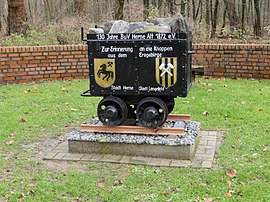Teutoburgia colliery
| Teutoburgia colliery | |||
|---|---|---|---|
| General information about the mine | |||
| Shaft frame shaft 1 | |||
| Information about the mining company | |||
| Operating company | Bochum Association | ||
| Employees | 1200 | ||
| Start of operation | 1866 | ||
| End of operation | 1929 | ||
| Successor use | Artificial forest, mining of mine gas | ||
| Funded raw materials | |||
| Degradation of | Hard coal | ||
| Geographical location | |||
| Coordinates | 51 ° 33 '9.7 " N , 7 ° 16' 40.9" E | ||
|
|||
| Location | Börnig | ||
| local community | Herne | ||
| Independent city ( NUTS3 ) | Herne | ||
| country | State of North Rhine-Westphalia | ||
| Country | Germany | ||
| District | Ruhr area | ||
The bill Teutoburgia was a coal - mine in Herne - Börnig .
history
On September 10, 1855 , the businessman Carl Wilhelm Rüping came to Holthausen and found what he was looking for. He called the seam "Laura". On August 6, 1856, he met a second time, namely at Gut Schlingenberg between the Callenberg house , the community of Holthausen and Obercastrop . The prospects were bought in 1866 by William Thomas Mulvany , who sank the first shafts . It soon turned out, however, that the mine field was too small for profitable coal extraction. Mulvany sold the mine pretty quickly.
As a buyer, the Bochum Association for Mining and Cast Steel Manufacture sunk shafts I and II again between 1905 and 1909 and started operations on April 1, 1911. But just eight months later, a serious mine accident occurred . Six miners were killed in a firedamp explosion . A year later there was another firedamp explosion, again with six deaths.
This colliery did not seem to be really profitable, despite its peak of over 1,100 miners, because there were repeated rumors about its closure and just as prompt denials. The rather dry coal was hard and impermeable to water - the ideal soil for the construction of the Rhine-Herne Canal in this region, but coal mining required enormous efforts and resources. The colliery was shut down in 1925. A good number of the 1200 or so workers found new work in the neighboring Constantin and Mont Cenis collieries . In 1929 the breakthrough took place between the Erin and Teutoburgia collieries in order to use Erin’s remaining reserves. At first, the shafts on Teuto were only used as weather shafts , before Erin's cable trip took place here. It was not until 1941 that Erin mined coal again on Teuto. This continued until 1983 before it was finally closed, which meant that 3800 miners were suddenly unemployed.
Shaft coordinates
Todays use
Today, the company premises have been completely cleared except for the headframe of shaft 1, the hoisting machine hall and part of the surrounding wall. The shaft openings are closed with covers . Excess mine gas can escape through a standpipe with a Protego hood .
The area was designed like a park and an artificial forest was set up, which is also listed in the Route of Industrial Culture. Various art objects lie on the walking paths. This also includes sound objects - sound compositions reminiscent of craft and industry can be heard from hidden speakers.
The head of the headframe is illuminated in the evening, which can be seen from afar from the nearby Autobahn 42 . The former machine hall is used by the sound artist Christoph Schläger as a workshop, experimental field and exhibition hall for his sound machines (see the Kunstwald web link).
On the western edge of the company premises, the Herner Stadtwerke use mine gases (mainly methane) that form in the disused mining tunnels. The cavities were drilled, the gas flowing out is used in a power plant with combined heat and power to supply district heating to the nearby Teutoburgia settlement and to generate electricity.
Shaft plaque for shaft 1 with the location coordinates in the Gauß-Krüger coordinate system
See also
literature
- Wilhelm Hermann, Gertrude Hermann: The old mines on the Ruhr. Past and future of a key technology. With a catalog of the "life stories" of 477 mines (= the blue books ). 6th edition expanded and updated by an excursus. Langewiesche, Königstein im Taunus 2008, ISBN 978-3-7845-6994-9 .
- Wolfgang Viehweger: Trace of Coal: Europe in Herne and Wanne-Eickel. Frischtexte Verlag, Herne 2000, ISBN 978-3-933059-03-1
- North Rhine-Westphalia Foundation (ed.). Erin memories. The restoration work on the Erin winding towers, Teutoburgia, Hammerkopfturm, main shaft 7. Druckerei Goergens und Lesaar GmbH, Düsseldorf.
Web links
- Description of this sight on the route of industrial culture
- Herne colliery: Teutoburgia colliery , city of Herne
- kunstwald , Christof Schläger
- Use of mine gas for district heating and power generation , Stadtwerke Herne









